Related Research Articles
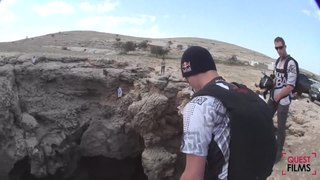
BASE jumping is the recreational sport of jumping from fixed objects, using a parachute to descend safely to the ground. "BASE" is an acronym that stands for four categories of fixed objects from which one can jump: buildings, antenna, spans (bridges), and earth (cliffs). Participants exit from a fixed object such as a cliff, and after an optional freefall delay, deploy a parachute to slow their descent and land. A popular form of BASE jumping is wingsuit BASE jumping.

A parachute is a device used to slow the motion of an object through an atmosphere by creating drag or, in a ram-air parachute, aerodynamic lift. A major application is to support people, for recreation or as a safety device for aviators, who can exit from an aircraft at height and descend safely to earth.

The Rogallo wing is a flexible type of wing. In 1948, Francis Rogallo, a NASA engineer, and his wife Gertrude Rogallo, invented a self-inflating flexible wing they called the Parawing, also known after them as the "Rogallo Wing" and flexible wing. NASA considered Rogallo's flexible wing as an alternative recovery system for the Mercury and Gemini space capsules, and for possible use in other spacecraft landings, but the idea was dropped from Gemini in 1964 in favor of conventional parachutes.

Wingsuit flying is the sport of skydiving using a webbing-sleeved jumpsuit called a wingsuit to add wetted area to the diver's body and generate increased lift, which allows extended air time by gliding flight rather than just free falling. The modern wingsuit, first developed in the late 1990s, uses a pair of fabric membranes stretched flat between the arms and flanks/thighs to imitate an airfoil, and often also between the legs to function as a tail and allow some aerial steering.

Powered paragliding, also known as paramotoring or PPG, is a form of ultralight aviation where the pilot wears a back-pack motor which provides enough thrust to take off using a paraglider. It can be launched in still air, and on level ground, by the pilot alone — no assistance is required.
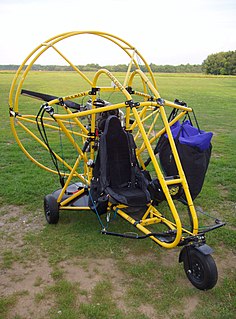
A powered parachute, often abbreviated PPC, and also called a motorized parachute or paraplane, is a type of aircraft that consists of a parafoil with a motor and wheels.
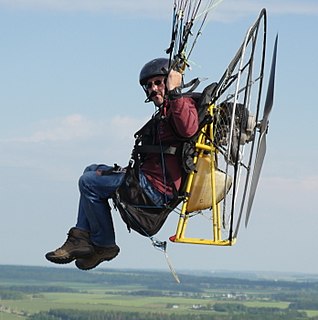
Paramotor is the generic name for the harness and propulsive portion of a powered paraglider ("PPG"). There are two basic types of paramotors: foot launch and wheel launch.

Canopy piloting encompasses several disciplines, all involving the flight of a skydiving parachute.
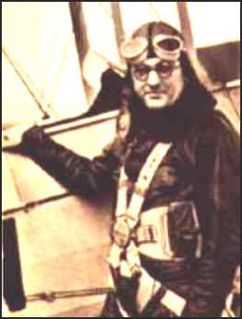
Leslie Leroy Irvin was a stunt-man for the fledgling Californian film industry. Flying in balloons, he performed using trapeze acrobatics and parachute descents. For the 1914 film Sky High, Irvin made his first jump out of an airplane while flying at 1,000 feet above the ground. In 1918, he developed his own life-saving static line parachute, jumping with it several times and promoting it to the US Army. Irvin joined the Army Air Service's parachute research team at McCook Field near Dayton, Ohio where he made the first premeditated free-fall jump with the modern parachute on April 28, 1919.

The United States Army Parachute Team, nicknamed the Golden Knights, is a demonstration and competition parachute team of the United States Army. It consists of demonstration and competition parachutist teams, drawn from all branches of the U.S. Army. Members must demonstrate excellence in parachuting.
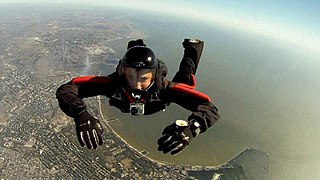
Parachuting, including also skydiving, is a method of transiting from a high point in the atmosphere to the surface of Earth with the aid of gravity, involving the control of speed during the descent using a parachute or parachutes.
Perris Valley Airport is a privately owned and operated airport open to public use and located one mile (1.6 km) southeast of Perris, serving Riverside County, California, United States. It has one runway and is used for general aviation and extensive skydiving. The airport operates from dawn to dusk daily year-round.
The Pro Swooping Tour (PST) is a professional competition circuit for an extreme form of parachuting called "canopy piloting". The PST was formed in 2003 by producer Jim P. Slaton and his associate Lyle Presse. Slaton & Lyle presented the sport's competition format and rules to the International Parachute Committee (IPC) at the 54th annual meeting in Brazil in 2003. The PST's efforts paid off and the IPC accepted the new sport of "Canopy Piloting". The PST created the competition format which gave birth to modern day canopy piloting.
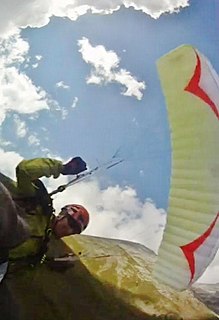
Speed-flying and speed riding are advanced disciplines of paragliding that use a small, high-performance paraglider wing to quickly descend heights such as mountains. Speed flying and speed riding are very similar sports; speed flying is when the speed wing is foot-launched, while speed riding is a winter sport done on skis.
H. Truesdell Smith—known variously as "H. T. Smith", "Henry Truesdell Smith", "Harold Truesdell Smith", or "Daredevil Smitty" but best known as "Smitty the Jumper"—was an American exhibition parachutist and skydiver of the 1920s and 1930s. He made periodic returns to skydiving starting in the late 1950s, jumping in every subsequent decade until his death, becoming widely known as "the oldest living skydiver", a title he claimed until his death in 1995 at the age of 96.
Daedalus Project is a brand of high performance and competition skydiving parachutes designed and manufactured by New Zealand manufacturer NZ Aerosports Ltd, for the sport of Canopy piloting.
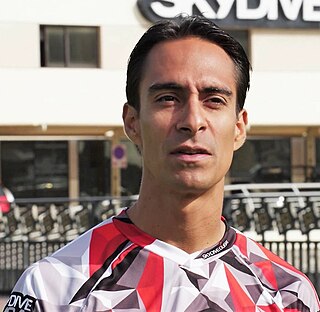
Ernesto Gainza Medina, is a professional skydiver, stunt performer and stunt coordinator, skydiving consultant, skydiving instructor and instructor examiner. He is also an experienced BASE jumper, wingsuit flyer and Guinness world record holder.
Luke Aikins is an American professional skydiver, BASE jumper, pilot, and aerial photographer. He is the first person to intentionally dive from mid-tropospheric altitude and land safely without a parachute or a wingsuit and the second skydiver to intentionally jump and safely land without using a parachute.

Jeff "Jeffro" Provenzano is an American professional skydiver, wingsuit flyer, BASE jumper, HALO jumper and stuntman. He is a member of the Red Bull Air Force, and is considered to be a pioneer of the skydiving discipline of swooping.

Ski-BASE jumping is the recreational sport of skiing at a high speed off of a cliff or mountain and free-falling through the air, using a parachute to descend to the ground, therefore combining the two sports of skiing and BASE jumping. Participants often perform tricks or manoeuvres during the freefall and remove their skis mid-air in order to safely deploy the parachute and land.
References
- ↑ Higgins, Matt (9 May 2008). "New Direction for Skydiving: From Vertical to Horizontal". The New York Times . Retrieved 22 February 2010.
- ↑ Brooks, Oakley (18 March 2006). "OUTDOORS; A Chute, Some Wind And a Sport Is Born". The New York Times . Retrieved 22 February 2010.